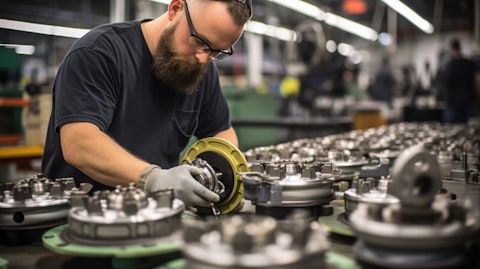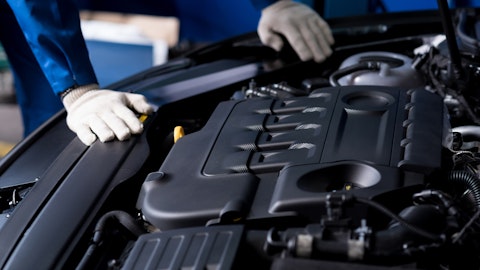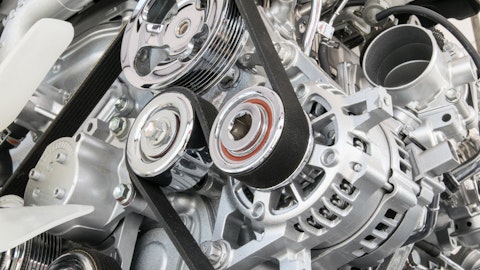American Axle & Manufacturing Holdings, Inc. (NYSE:AXL) Q3 2023 Earnings Call Transcript November 3, 2023
American Axle & Manufacturing Holdings, Inc. misses on earnings expectations. Reported EPS is $-0.11 EPS, expectations were $-0.04.
Operator: Good morning, everyone. My name is Jamie, and I will be your conference facilitator today. At this time, I would like to welcome everyone to the American Axle & Manufacturing Third Quarter 2023 Earnings Conference Call. All lines have been placed on mute to prevent any background noise. After the speakers’ remarks, there will be a question-and-answer period. [Operator Instructions] As a reminder, today’s conference call is being recorded. At this time, I’d like to turn the floor over to Mr. David Lim, Head of Investor Relations. Please go ahead, Mr. Lim.
David Lim: Great. Thank you, and good morning from Detroit. I’d like to welcome everyone who is joining us on AAM’s third quarter earnings call. Earlier this morning, we released our third quarter of 2023 earnings announcement. You can access this announcement on the Investor Relations page of our website www.aam.com and through the PR Newswire services. You can also find supplemental slides for this conference call on the Investor page of our website as well. To listen to a replay of this call, you can dial 1 (877) 344-7529, replay access code 5629227. This replay will be available through November 10. Before we begin, I’d like to remind everyone that the matters discussed in this call may contain comments and forward-looking statements subject to risks and uncertainties, which cannot be predicted or quantified, which may cause future activities and results of operations to differ materially from those discussed.
For additional information, we ask that you refer to our filings with the Securities and Exchange Commission. Also during this call, we may refer to certain non-GAAP financial measures. Information regarding these non-GAAP measures as well as a reconciliation of these non-GAAP measures to GAAP financial information is available on our website. With that, let me turn things over to AAM’s Chairman and CEO, David Dauch.
David Dauch: Thank you, David, and good morning, everyone. Thanks for joining us today to discuss AAM’s financial results for the third quarter of 2023. With me on the call today is Chris May, our Executive Vice President and Chief Financial Officer. To begin my comments, I’ll review the highlights of our third quarter financial performance. I will then provide deeper insights into our operating performance issues and what we are doing to bring AAM back to our traditional standards. And then next, I’ll touch on significant business development news in the quarter as we continue to make excellent strides in winning both electrification and ICE programs. Our strong product portfolio of both verticals allows us to fully support OEM driveline needs across multiple platforms and technologies.
After Chris covers the details of our financial results, we’ll open up the call for any questions that you all may have. So let’s begin. AAM’s third quarter of 2023 sales were $1.55 billion. AAM sales were negatively impacted by continued customer production volatility stemming from supply chain challenges, including lack of labor availability and delivery constraints within the supply base. From AAM’s perspective, the customer production volatility in the third quarter was significantly greater versus the second quarter. This was further exacerbated by the UAW work stoppage that began in the middle of September. From a profitability perspective, AAM’s adjusted EBITDA in the third quarter was $157 million or 10.1% of sales. The margin performance reflects the negative impact of customer production volatility, including the UAW work stoppage, elevated input costs, continued operational challenges at certain AAM plants that are having an outsized influence on profitability and a warranty charge in the quarter associated with the casting component.
Compounding our matters in the third quarter, economic recoveries have not been reached – have not reached final resolution in part because of the distraction of the UAW work stoppage with our top three customers, but discussions are very active in the fourth quarter. Taken as a whole, this performance is not up to AAM standards, and Chris will provide more details about our financial performance in a few moments. AAM’s adjusted earnings per share in the third quarter of 2023 was a loss of $0.11 per share. AAM generated a strong positive cash flow in the quarter. AAM’s adjusted free cash flow was very strong at nearly $136 million in the third quarter compared to $46 million last year. On Slide 4 of our presentation deck, we have outlined headwinds that we have faced all year, a [view stem] from the current operating environment and others are AAM internal.
This is very disappointing for me and my management team as we pride ourselves on our operational excellence and our performance execution. As we mentioned earlier this year, we continue to experience operational challenges at several of our plants, especially in the Metal Forming business unit. We are driving for the resolution of a majority of these issues as we exit 2023 and the remainder shortly thereafter. Internally, the combination of labor availability, plant throughput challenges and capacity constraints were major contributors to the cost headwinds this quarter. Additional resources have certainly been dispatched to address these operational issues. On a brighter note, our team has been doing a marvelous job securing new business with our innovative products and new customers.
So looking at Page 5 of our presentation deck, the e-Beam momentum continues for our company here at AAM. You may recall in the first quarter, we announced a significant e-Beam axle award with Stellantis. That was followed up in the second quarter with additional award from an undisclosed Asian OEM for the China market. Today, we are very happy to announce two additional e-Beam awards, one from Skywell Auto, supporting an electric van program with a 2-in-1 e-Beam axle in China. This program is slated to launch in 2024. The other win is with Mahindra in India. AAM will supply e-Beam axles for Mahindra’s 2.5 ton light electric trucks scheduled for launch in 2025. Furthermore, we continue to win programs with our ICE business. AAM will provide PTUs and RDMs for multiple JETOUR, which is a brand of Chery vehicle programs beginning in 2024.
In addition, AAM will also supply independent front axles for a number of FAW plug-in hybrid programs in China beginning in 2025. Today’s announcements reinforce AAM’s broad EV and ICE product portfolio, our capabilities, our technology and our approach to the market. From a recognition standpoint, we are also very excited to share that AAM has been named a 2023 Automotive News PACEpilot Award finalist for our innovative electric beam axle with high-speed motor and integrated inverter. Our technology can be scaled to cover Class 1 trucks and vans through Class 6 commercial vehicles. Since 2020, AAM has received 5 Automotive News PACE and PACEpilot awards demonstrating the company’s innovation leadership and electrification. To conclude my opening remarks, let’s talk about our updated guidance, and please refer to Slide 6 of our presentation deck.
AAM is now targeting sales of $6 billion to $6.1 billion, adjusted EBITDA of approximately $660 million to $685 million, adjusted free cash flow of approximately $200 million to $215 million. And according to S&P, 2023 North American production approximates 15.2 million units. However, as you all know, our sales performance is more dependent on production of certain significant platforms with specific customers. Related to the UAW work stoppage, our guidance assumes the resumption of production by the first week of November and an overall work stoppage impact of approximately $70 million to $100 million in sales and $25 million to $40 million in adjusted EBITDA. I assure you that AAM’s management team continues to work with a strong resolve to navigate these dynamic and challenging times.

In addition, AAM will continue to drive our efforts towards securing our legacy business, generating strong free cash flow, strengthening our balance sheet, advancing our electrification portfolio and position AAM for profitable growth. Let me now turn the call over to our Executive Vice President and Chief Financial Officer, Chris May. Chris?
Christopher May: Thank you, David, and good morning, everyone. I will cover the financial details of our third quarter with you today. I will also refer to the earnings slide deck as part of my prepared comments. So let’s go ahead and begin with sales. In the third quarter of 2023, AAM sales were $1.55 billion compared to $1.54 billion in the third quarter of 2022. Slide 8 shows a walk of third quarter 2022 sales to third quarter 2023 sales. Positive volume mix and other was $55 million, driven in large part due to our backlog. The UAW work stoppage had a $15 million negative impact to sales in the quarter. And lastly, metal market pass-throughs and FX lowered net sales by approximately $19 million with metal lower and FX higher.
Overall, while North American production was up close to 9% year-over-year in the quarter, in total, our primary full-sized truck platforms were down approximately 4%. And in the third quarter, we experienced extended downtime at some of our customers’ full-size truck plants greater than what we experienced in prior quarters. Now let’s move on to profitability. Gross profit was $131 million in the third quarter of 2023 as compared to $177 million in the third quarter of 2022. Adjusted EBITDA was $156.8 million in the third quarter of 2023 versus $198.4 million last year. You can see the year-over-year walk down of adjusted EBITDA on Slide 9. In the quarter, volume, mix and other added $15 million of adjusted EBITDA, reflecting a 27% contribution margin on AAM’s higher sales.
The UAW work stoppage had a $4 million impact to the quarter. In addition, we experienced a warranty charge of $13 million associated with the casting component from our Metal Forming business unit. The combination of net inflation, performance, launch costs and other impacted EBITDA by approximately $30 million in the quarter. The primary drivers behind this bucket were operational inefficiencies at certain underperforming plants and net year-over-year inflation in several of our cost areas. Collectively, these drivers caused excessive labor costs that represented approximately half of this total, net inflation of about 20% to 30% of this total and excessive scrap and premium freight for most of the remainder. All of these issues are addressable in the manner in which David mentioned.
You will also note that metal market and FX was lower year-over-year. Metals were favorable and FX was negative, principally driven by the strength of the Mexican peso. Let me now cover SG&A. SG&A expense, including R&D, in the third quarter of 2023 was $81.8 million or 5.3% of sales. This compares to $85.7 million or 5.6% of sales in the third quarter of 2022. AAM’s R&D spending in the third quarter of 2023 was approximately $35 million. As we indicated entering into 2023, R&D will trend in the $35 million to $40 million range per quarter as we continue to invest in our electric drive technology, capitalizing on the growing number of electrification opportunities that are before us and launching new programs. Let’s move on to interest and taxes.
Net interest expense was $43.7 million in the third quarter of 2023 compared to $39.4 million in the third quarter of 2022. Although our total debt is lower at quarter end on a year-over-year basis, the rising rate environment drove the interest expense increase. In the third quarter of 2023, our income tax was a $2 million benefit as compared to a benefit of $5.7 million in the third quarter of 2022. For 2023, we expect our adjusted effective tax rate to be elevated at approximately minus 100% at the midpoint of our guidance range. This very unusual looking rate is driven by the recording of a valuation allowance that we have discussed in previous calls. We also expect cash taxes of approximately $55 million to $60 million this year. Taking all this into account, our GAAP net income was a loss of $17.4 million or $0.15 per share in the third quarter of 2023 compared to a net income of $26.5 million or $0.22 per share in the third quarter of 2022.
Adjusted earnings per share, which excludes the impact of items noted in our earnings press release, was a loss of $0.11 per share in the third quarter of 2023 compared to earnings of $0.27 per share in the third quarter of 2022. Let’s now move to cash flow and the balance sheet. Net cash provided by operating activities for the third quarter of 2023 was $178.3 million. Capital expenditures net of proceeds from the sale of property, plant and equipment for the third quarter of 2023 were $47.5 million. Cash payments for restructuring and acquisition-related activity for the third quarter of 2023 were $5 million. Reflecting the impact of these activities, AAM generated adjusted free cash flow of $135.8 million in the quarter. This is one of our top-performing cash flow quarters over the last several years.
From a debt leverage perspective, we ended the quarter with net debt of $2.2 billion and LTM adjusted EBITDA of $682 million, calculating a net leverage ratio of 3.3x at September 30. As for the rest of the year, Slide 6 shows our full-year guidance. Our 2023 financial targets have been updated to reflect our estimate that the UAW work stoppage well have on our operations. For sales, we are targeting a range of $6 billion to $6.1 billion for 2023. The sales target is based upon our production assumptions for our key programs, and we estimate that General Motors large truck production will be at 1.3 million to 1.35 million units this year, roughly flattish at the midpoint year-over-year. Our guidance also assumes that production resumes and begins to ramp up during the first week of November on the UAW work stoppage.
We estimate that the impact of the work stoppage will reduce sales by $70 million to $100 million and adjusted EBITDA by $25 million to $40 million. Our adjusted EBITDA target is $660 million to $685 million, and our adjusted free cash flow target is $200 million to $215 million. This guidance reflects the impact of the UAW work stoppage, our third quarter performance and warranty charge and tracks with our performance overview on Slide 4. Although we are not providing formal 2024 guidance, we would like to provide a number of initial guideposts or factors to consider. On the cost side, we expect our underperforming plans to positively contribute by early next year. The higher warranty item included in adjusted EBITDA in the third quarter of 2023 should not repeat next year, and we will lap the UAW work stoppage.
In addition, less production volatility should convert to better operational efficiencies and reduced premium costs. For the topline, the industry continues to be positioned for production growth year-over-year, the magnitude of which will be better served once the dust finally settles with production restarts post the UAW work stoppage. As David mentioned, we are focused on operational improvements as these inefficiencies that we are experiencing are very flexible, making progress with our commercial recovery discussions with our customers; and lastly, securing both prospective ICE and EV business. Thank you for your time and participation on the call today. I’m going to stop here and turn the call back over to David, so we can start Q&A.
David Lim: Thank you, Chris and David. We have reserved some time to take questions. I would ask that you please limit your questions to no more than two. So at this time, please feel free to proceed with any questions you may have.
See also 12 Best Small-Cap Biotech Stocks with Massive Potential According to Hedge Funds and 12 Best Large Cap Stocks To Buy Now.
Q&A Session
Follow American Axle & Manufacturing Holdings Inc (NYSE:AXL)
Follow American Axle & Manufacturing Holdings Inc (NYSE:AXL)
Operator: [Operator Instructions] Our first question today comes from Ryan Brinkman from JPMorgan. Please go ahead with your question.
Ryan Brinkman: Great. Thanks for taking my question, which is on the operating inefficiencies. Of course, the UAW work stoppage was outside your ability to control. And so I see us called out separately on Slide 9. It would be great to get a sense though of the $30 million year-over-year negative bucket of EBITDA drivers related to net inflation, performance, launch and other also on that side. How much of that may relate to these operating inefficiencies you’re talking about? And then of that amount, how much would you say relates to factors truly outside your control similar to the UAW work stoppage such as customer volatility and customer production such as with the GM full-size truck program, et cetera, versus how much might maybe lie more within your organization, and so therefore, better within your ability to control? And what is your line of sight to mitigating those factors?
Christopher May: Yes, Ryan. Good morning. This is Chris. I’ll take the first part of that question. I’ll dimensionalize that $30 million from a dollar perspective, and then I’ll turn it over to David to give you some commentary related to some other elements of your question. So if you think about the $30 million on a year-over-year basis, about half of that is driven by labor inefficiencies inside, I would say, our own operations, mostly on the metal form business unit side of the house. It’s premium labor cost. Over time, I would call it, excessive cost we had to pay for – to bring third-party personnel to assist with maintenance and temporary workers as we were working through some of our challenges, again, all fixable.
About 20% to 30% of this is net inflation. So we may have some wage inflation. We have some inflation from the supply base. That, of course, as you know, we’re working through with some potential customer recoveries to offset some of that. And then the remaining piece is excessive scrap, premium freight associated with some of these inefficiencies that we have. And again, once we start to temper down some of those inefficiencies, these costs as well will start to dissipate in the near-term. So that sort of dimensionalize it from a dollar perspective. I’ll turn it over to David for some…
David Dauch: Yes, Ryan. This is David. Chris touched on and you touched on the customer production downtime was much higher in the third quarter than it was in the second quarter. We made a choice to hold on to our people during that period of time. Similar situation with the UAW work stoppage because of the dynamic environment that we’re operating in from a labor availability issue, we chose to hold on to our people and did some voluntary layoffs based on their own selection. That drove some premium cost for us that normally we wouldn’t carry with us. As Chris indicated, we also had some operational inefficiency and throughput issues at a couple of our metal forming plants, specifically related more towards the powder metal side.
Again, that’s largely driven because of labor availability issues. Once you have experienced workers that are leaving the business or have left the business, you bring new or temporary workers in. There’s a learning curve to go through that drives excess of scrap and drives other premium costs in the business. But we’ve got our hands on it, and we’re getting things stabilized. And as Chris indicated, we feel that we’ll have most of that cleaned up by the end of the year, a little bit into the first quarter of next year. We did in the quarter experienced some unexpected downtime at our Three Rivers facility in – on the driveline side of our business. That issue has been addressed. It’s resolved. It’s behind us now. So our real focus is on the metal form side of our business and just continuing to fix and address the issues that are largely within our control.
The biggest thing that we don’t control in this whole thing is just customer schedules, and we experienced a lot of volatility in the third quarter.
Ryan Brinkman: Okay. Great. Thanks. And then just lastly for me, sort of as a follow-up to some of those awards that are shown on Slide 5 and taking into account the pretty plentiful electrification awards, especially on the e-beam axle side that you announced in conjunction with 1Q and 2Q earnings. Is there maybe any sort of preview that you might be able to provide for when you announced in January, your – you’ve rolled the 2023 through 2025 backlog to reflect 2024 through 2026. How that might track? Or is on pace to track, including relative to the 40% of backlog that was announced last January that related to electrification products.
Christopher May: Yes, Ryan, this is Chris. We’re not providing any update to our backlog information. As you know, we – customarily, will release that with our first quarter earnings call. But you’ve seen us through the course of the year, continue to win in various electric drive e-Beam axles, but also on some of our ICE business as well.
David Dauch: Ryan, this is David. I just expect it to be positively received.
Ryan Brinkman: Okay. Thank you very much.
Operator: Our next question comes from John Murphy from Bank of America. Please go ahead with your question.
Unidentified Analyst: Good morning. This is [Federico Merendi] on for John Murphy. My first question is, so the UAW strike has raised the labor cost at the OEMs and especially their internal axle plants. How does this translate to axle labor costs? Do you see any spillover effect?
David Dauch: Well, I mean, clearly, we’re not an OEM, and we don’t pay OEM wages nor do any of the other Tier 1s that are out there. But at the same time, we have to be sensitive to the movement that’s taking place in regards to some of the component operations within the OEMs. Obviously, we’re all in the market, and there’s a war on talent. And we got to be able to not only attract the talent but retain the talent. And obviously, this again put pressure on the whole industry, not just American Axle or the axle business. So we’re constantly reviewing our wage and benefit structure. We’re looking at that against the market and the competition to make sure that we can be at or above where the market is to make sure we have a stable workforce.
We do expect that there will be downward pressure that will cascade down based on the result of the OEM negotiations, and we’ll be prepared to address it appropriately. At the same time, we’ll look at what other things that we can do to automate our factories as much as we possibly can to mitigate some of the labor complement if need be in order to maintain and address our cost structure.
Unidentified Analyst: Thank you. And my second question is on electrification. So it’s great to hear that you won more programs in Asia. And I was wondering, can you give us an estimate on how those programs are impacting margins? And given that in the last few weeks, everybody is talking about the slower demand in EVs. How does this impact your future programs, more expectation on electric vehicles?




